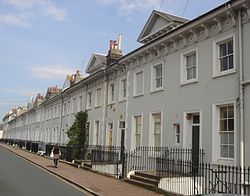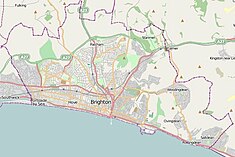Park Crescent, Brighton
| Park Crescent | |
|---|---|

The rear elevation of 1–16 Park Crescent
|
|
| Location | Park Crescent, Round Hill, Brighton and Hove, East Sussex, United Kingdom |
| Coordinates | 50°49′57″N 0°07′53″W / 50.8324°N 0.1314°WCoordinates: 50°49′57″N 0°07′53″W / 50.8324°N 0.1314°W |
| Built | 1849–1854 |
| Rebuilt | 1983 (Numbers 24–26) |
| Architect | Amon Henry Wilds |
| Architectural style(s) | Italianate |
|
Listed Building – Grade II*
|
|
| Official name: Nos. 1–16 Park Crescent (Consecutive); Nos. 17–24 and 26–32 Park Crescent (Consecutive); Nos. 33–48 Park Crescent (Consecutive) |
|
| Designated | 24 July 1969 |
| Reference no. | 481018; 481021; 481022 |
|
Location within Brighton and Hove
|
|
Park Crescent is a mid-19th-century residential development in the Round Hill area of Brighton, part of the English city of Brighton and Hove. The horseshoe-shaped, three-part terrace of 48 houses was designed and built by one of Brighton's most important architects, Amon Henry Wilds; by the time work started in 1849 he had 35 years' experience in the town. Wilds used the Italianate style rather than his (and Brighton's) more common Regency motifs. Three houses were replaced after the Second World War because of bomb damage, and another was the scene of one of Brighton's notorious "trunk murders" of the 1930s. The three parts of the terrace, which encircle a private garden formerly a pleasure ground and cricket pitch, have been listed at Grade II* by English Heritage for their architectural and historical importance.
The fishing village of Brighthelmston, on the English Channel coast, was built around the point at which the Wellesbourne, a winterbourne flowing off the South Downs, entered the sea. It formed a north–south valley along which the road and railway line to London were built. The road to London diverged from the road to Lewes, which also followed a valley northeastwards, at an area of marshy, intermittently flooded ground called The Level. By the 18th century, when the village started developing into the fashionable resort of Brighton, this had become a popular site for fairs, sports and general recreation. In 1791, the northernmost part became the Prince of Wales Ground, a cricket ground which hosted early first-class matches and served as the home of Brighton Cricket Club, one of the principal founders of Sussex County Cricket Club 50 years later.
...
Wikipedia

